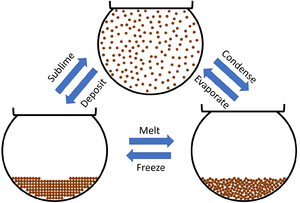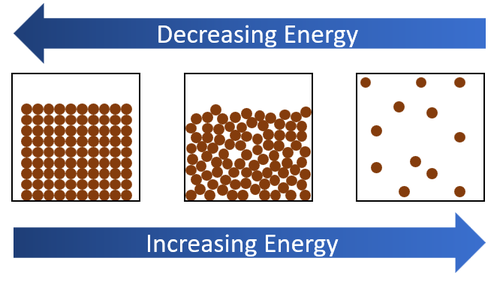Difference between revisions of "State Change"
(→Energy and State Changes) |
|||
| Line 34: | Line 34: | ||
*[[Melting]], [[Evaporating]] and [[Subliming]] are [[endothermic]] changes because they need [[energy]] to happen. The [[material]] has more [[energy]] at the end than it did the beginning. | *[[Melting]], [[Evaporating]] and [[Subliming]] are [[endothermic]] changes because they need [[energy]] to happen. The [[material]] has more [[energy]] at the end than it did the beginning. | ||
| + | : When a [[solid]] [[melting|melts]] [[energy]] is needed to break the [[bond]]s holding the [[particle]]s in fixed positions. | ||
| + | : When a [[liquid]] [[evaporating|evaporates]] [[energy]] is needed to break the [[bond]]s that keep the [[particle]]s together. | ||
| + | : When a [[solid]] [[subliming|sublimates]] [[energy]] is needed to break the [[bond]]s holding the [[particle]]s in fixed positions and keeping the [[particle]]s together. | ||
| + | |||
*[[Freezing]], [[Condensing]] and [[Depositing]] are [[exothermic]] changes because it releases [[energy]] when it happens. The [[material]] has less [[after]] it has happened. | *[[Freezing]], [[Condensing]] and [[Depositing]] are [[exothermic]] changes because it releases [[energy]] when it happens. The [[material]] has less [[after]] it has happened. | ||
| + | : When a [[gas]] [[condensing|condenses]] [[energy]] is released as [[bond]]s form between adjacent [[molecule]]s to hold them together. | ||
| + | : When a [[liquid]] [[freezing|freezes]] [[energy]] is released as [[bond]]s form between adjacent [[molecule]]s to keep them in fixed positions. | ||
| + | : When a [[gas]] [[depositing|deposits]] [[energy]] is released as [[bond]]s form between adjacent [[molecule]]s to hold them together and keep them in fixed positions. | ||
: When [[human]]s [[sweat]] the [[water]] [[evaporation|evaporates]] from the [[skin]] helping them cool down. This works because [[evaporation]] is an [[endothermic]] process so the [[sweat]] takes [[energy]] away from the [[skin]] when it [[evaporation|evaporates]]. | : When [[human]]s [[sweat]] the [[water]] [[evaporation|evaporates]] from the [[skin]] helping them cool down. This works because [[evaporation]] is an [[endothermic]] process so the [[sweat]] takes [[energy]] away from the [[skin]] when it [[evaporation|evaporates]]. | ||
Revision as of 18:00, 29 September 2018
Contents
Key Stage 2
Meaning
A state change is when a material changes from one state of matter to another.
About State Changes
- A state of matter can change if the temperature changes.
- Melting is when solid turns into a liquid.
- Freezing is when a liquid turns into a solid.
- Evaporating is when a liquid turns into a gas.
- Condensing is when a gas turns into a liquid.
Key Stage 3
Meaning

This diagram shows the changes of state between the three states of matter.
A state change is when a material changes from one state of matter to another.
About State Changes
- A state of matter can change if the temperature changes.
- Melting is when solid turns into a liquid.
- Freezing is when a liquid turns into a solid.
- Evaporating is when a liquid turns into a gas.
- Condensing is when a gas turns into a liquid.
- Subliming is when a solid turns into a gas.
- Depositing is when a gas turns into a solid.
Energy and State Changes
| When energy is added by heating a solid will turn into a liquid and then a liquid will turn into a gas. When energy is taken away by cooling a gas will turn into a liquid and a liquid will turn into a solid. |
- Melting, Evaporating and Subliming are endothermic changes because they need energy to happen. The material has more energy at the end than it did the beginning.
- When a solid melts energy is needed to break the bonds holding the particles in fixed positions.
- When a liquid evaporates energy is needed to break the bonds that keep the particles together.
- When a solid sublimates energy is needed to break the bonds holding the particles in fixed positions and keeping the particles together.
- Freezing, Condensing and Depositing are exothermic changes because it releases energy when it happens. The material has less after it has happened.
- When a gas condenses energy is released as bonds form between adjacent molecules to hold them together.
- When a liquid freezes energy is released as bonds form between adjacent molecules to keep them in fixed positions.
- When a gas deposits energy is released as bonds form between adjacent molecules to hold them together and keep them in fixed positions.
- When humans sweat the water evaporates from the skin helping them cool down. This works because evaporation is an endothermic process so the sweat takes energy away from the skin when it evaporates.
